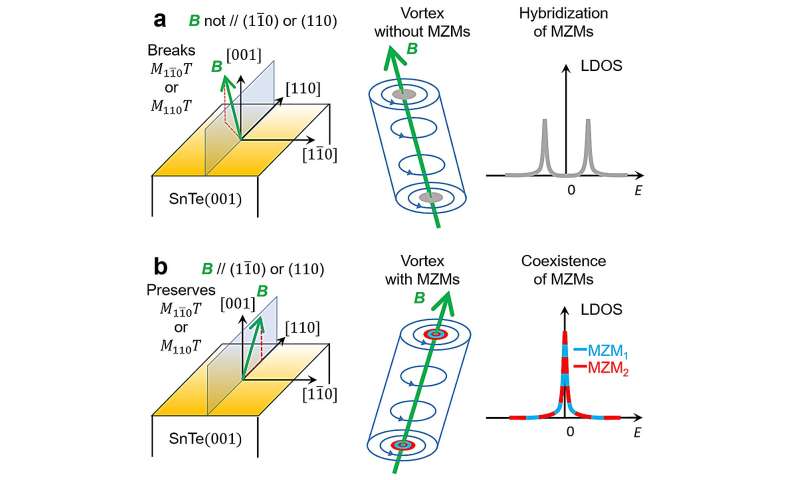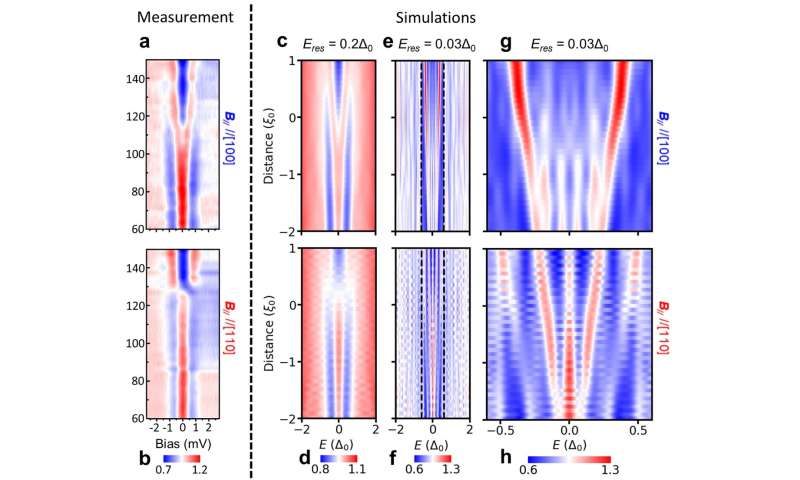This article has been reviewed according to Science X's editorial process and policies. Editors have highlighted the following attributes while ensuring the content's credibility:
fact-checked
peer-reviewed publication
trusted source
proofread
Physics researchers identify new multiple Majorana zero modes in superconducting SnTe

A collaborative research team has identified the world's first multiple Majorana zero modes (MZMs) in a single vortex of the superconducting topological crystalline insulator SnTe and exploited crystal symmetry to control the coupling between the MZMs.
This discovery, published in Nature, offers a new pathway to realizing fault-tolerant quantum computers. The team was led by Prof. Junwei Liu, Associate Professor in the Department of Physics at the Hong Kong University of Science and Technology (HKUST), and Prof Jinfeng Jia and Prof Yaoyi Li from Shanghai Jiao Tong University (SJTU).
MZM is a zero-energy topologically nontrivial quasiparticle in a superconductor that obeys non-Abelian statistics, allowing for inequivalent braiding sequences, even though the total number of exchanges is the same. This contrasts with ordinary particles, such as electrons or photons, where different braiding always results in the same final state. This unique property protects MZMs from local perturbations, making them an ideal platform for robust fault-tolerant quantum computation.
Although significant progress has been made in engineering artificial topological superconductors, the braiding and manipulation of MZMs remain extremely challenging due to their separation in real space, which complicates the necessary movements for hybridization.
The newly published work collaborated by the theoretical group at HKUST and experimental group at SJTU, took a completely different approach by taking advantage of the unique feature of crystal-symmetry-protected MZMs to eliminate these bottlenecks.
They demonstrated for the first time the existence and hybridization of magnetic-mirror-symmetry-protected multiple MZMs in a single vortex of the superconducting topological crystalline insulator SnTe, using controlled methods that do not require real space movement or strong magnetic fields, leveraging their extensive experience in low-temperature scanning tunneling microscopy, high-quality sample growth, and large-scale theoretical simulations.
-

Schematics for controllable hybridization of MT protected MZMs using tilted magnetic fields. (a) The magnetic field is not parallel to the 110 or 110 mirror planes and breaks the symmetry that protects the MZMs. (b) The magnetic field is parallel to the 110 or 110 mirror planes and preserves the symmetry that protects the MZMs. Left: Schematics for the tilted magnetic field and the mirror planes. Middle: Schematics for the tilted vortex line. Right: Schematics for the local density of states showing the nonexistence or existence of the MZMs. Credit: HKUST -

Signatures of crystal-symmetry-protected MZMs. (a, b) Spatially resolved tunneling conductance spectra in tilted magnetic fields. (c-h) Simulated local density of states for vortex states in tilted magnetic fields. Credit: HKUST
The experimental group at SJTU observed significant changes in the zero-bias peak, a strong indicator of MZMs, in the SnTe/Pb heterostructure under tilted magnetic fields. The HKUST theoretical team subsequently performed extensive numerical simulations to unambiguously demonstrate that the anisotropic responses to tilted magnetic fields indeed originate from crystal-symmetry-protected MZMs.
By utilizing the kernel polynomial method, they successfully simulated large vortex systems with hundreds of millions of orbitals, enabling further exploration of novel properties in vortex systems beyond just crystal-symmetry-protected MZMs. The research opens a new frontier for detection and manipulation of crystal-symmetry-protected multiple MZMs.
Their findings pave the way for the experimental demonstration of non-Abelian statistics, and the construction of new types of topological qubits and quantum gates based on crystal-symmetry-protected multiple MZMs.
More information: Tengteng Liu et al, Signatures of hybridization of multiple Majorana zero modes in a vortex, Nature (2024). DOI: 10.1038/s41586-024-07857-4
Journal information: Nature
Provided by Hong Kong University of Science and Technology





















